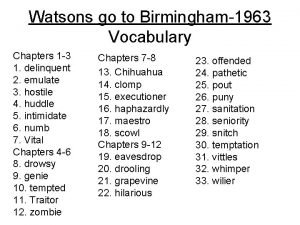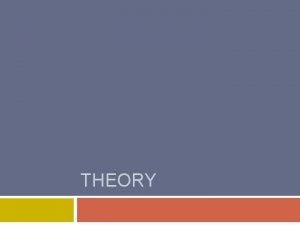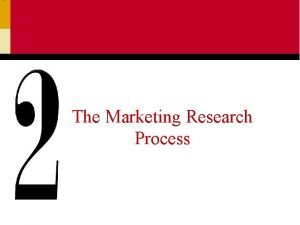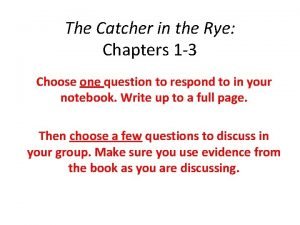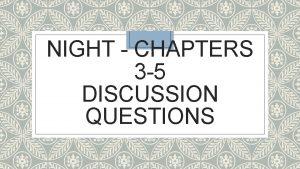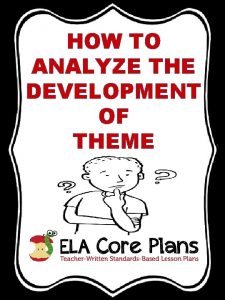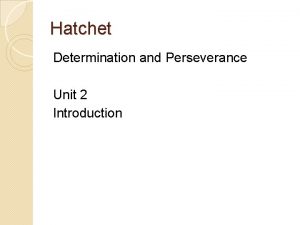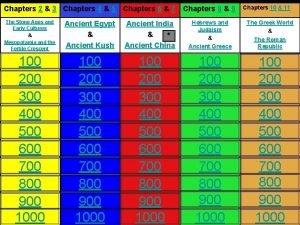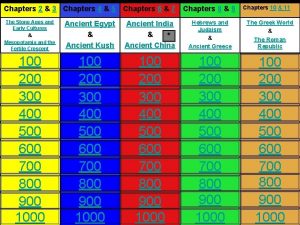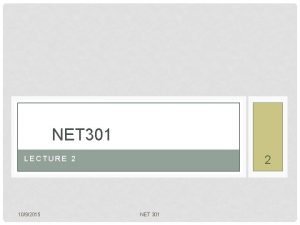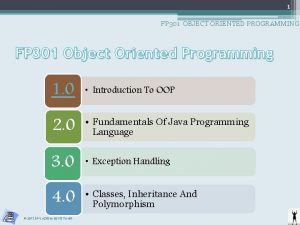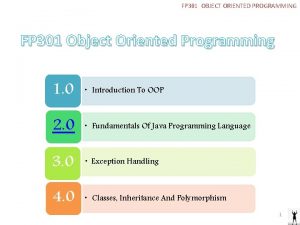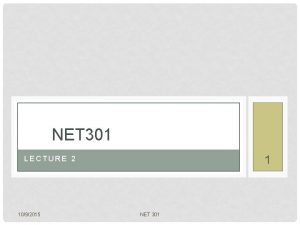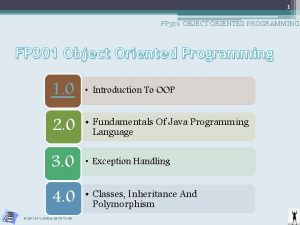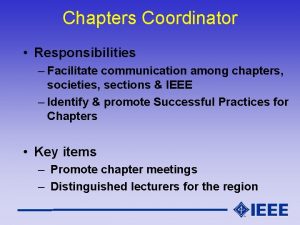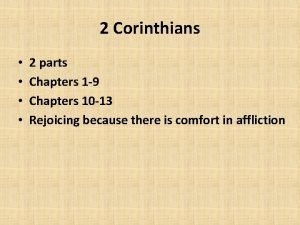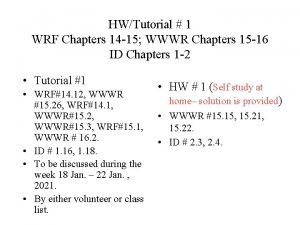CS 301 Introduction Chapters 1 2 CS 301









































- Slides: 41

CS 301 Introduction – Chapters 1 -2

CS 301 • For students who entered our program prior to Fall 2018 – You can take 300, 301, 495, 4 xx in ANY ORDER – We cannot enforce the new prerequisites – But, we encourage you to take 300, 301 before your 4 xx courses! – Note that we also cannot enforce the C- or better in CS 301, so a D- is passing • For students who entered our program on or after Fall 2018, the prerequisites are enforced and you need a C- or better in this class

Relevance of Databases • DBs are a part of most decisions in an enterprise – Traditional DBs – Operational – Data Warehouses – Decision Support – No. SQL DBs – Information, Big data

Databases • Databases play a critical role in? – Business, medicine, industry, etc. , – everything? • Databases can be? – Relational, XML, Object-relational, multimedia, Web, VERY large, No. SQL • What databases have you used today?

Data vs. Databases • Data – Recorded known facts, implicit meaning • Database (DB) – Logically coherent collection of related data – Represents some aspect of the real-world known as a mini -world or universe of discourse – Designed, built for specific purpose, specific purpose and group of users

Database Management System • Database Management System (DBMS) – Software program to • Create and maintain a DB • Define types of data • Manipulate data • Store on disk controlled by DBMS

Data vs DBMS vs DBS • Data – Recorded known facts • Database – Collection of data • Database Management System – Computer program for managing databases • Database System – Data + DBMS

Data and Metadata • Data – Has Records and Data elements • Metadata – “data about data” – Types of data elements – Structure of Records – Constraints

Database

Database { "_id" : Object. Id("5 be 9 d 3809645938881769 ba 8"), "Request. ID" : 2, "Start. Date" : "10/10/2014", "End. Date" : "10/10/2014", "Agency. Name" : "HRA/DEPT OF SOCIAL SERVICES", "Section. Name" : "Changes in Personnel", "Additional. Description 1" : "Effective Date: 01/05/2014; Provisional Status: Yes; Title Code: 10104; Reason For Change: RESIGNED; Salary: 32467. 00; Employee Name: HOSSAIN, MD H. " } { "_id" : Object. Id("5 be 9 d 3859645938881785689"), "Request. ID" : 3, "Start. Date" : "10/10/2014", "End. Date" : "10/10/2014", "Agency. Name" : "POLICE DEPARTMENT", "Section. Name" : "Changes in Personnel", "Additional. Description 1" : "Effective Date: 10/22/2013; Provisional Status: Yes; Title Code: 10144; Reason For Change: DECREASE; Salary: 37755. 00; Employee Name: LEE, JOSEPHIN S. " }

Metadata - Database Catalog Object_name No_of_columns Student 4 Course 4 Section 5 Grade_Report 3 Prerequisite 2 Column_name Data_type Belongs_to Name Char(30) Student_number Char(4) Student Char(10) Course … Course_name …

Metadata - Schema Student (Name, Student_number, Class, Major, SSN) Name Student_number Class Major SSN

Metadata and Data { "_id" : Object. Id("5 be 9 d 3809645938881769 ba 8"), "Request. ID" : 2, "Start. Date" : "10/10/2014", "End. Date" : "10/10/2014", "Agency. Name" : "HRA/DEPT OF SOCIAL SERVICES", "Section. Name" : "Changes in Personnel", "Additional. Description 1" : "Effective Date: 01/05/2014; Provisional Status: Yes; Title Code: 10104; Reason For Change: RESIGNED; Salary: 32467. 00; Employee Name: HOSSAIN, MD H. " } { "_id" : Object. Id("5 be 9 d 3859645938881785689"), "Request. ID" : 3, "Start. Date" : "10/10/2014", "End. Date" : "10/10/2014", "Agency. Name" : "POLICE DEPARTMENT", "Section. Name" : "Changes in Personnel", "Additional. Description 1" : "Effective Date: 10/22/2013; Provisional Status: Yes; Title Code: 10144; Reason For Change: DECREASE; Salary: 37755. 00; Employee Name: LEE, JOSEPHIN S. " }

Meta Data for a DB Incomplete Definition – Data object name, its characteristics, data types – Account#, when created, modified

Meta Data • Three categories of meta data (books as example): – Structural metadata: A way to define how objects are put together • how pages are ordered to form chapters. – Administrative metadata: Information to help manage a resource • when and how it was created, types, and who has access – Descriptive metadata: A resource for discovery and identification • including elements such as title, abstract, author, and keywords.

Meta Data – Complete Definition • Structural – Student (Name, CWID, address, GPA, major) • Administrative – Owner of data • Account#, when created, modified, who can access • Descriptive: – Everything but the content – constraints, max/min values

Meta Data - Examples • Metadata associated with emails: – Sender's name, email, and IP address – Recipient's name and email address – Date, time, and time zone – Mail client header formats – Unique identifier of email and related emails – Mail client login records with IP address – Subject of email

Meta Data - Examples • Metadata associated with texting: – Phone number of participants – Time of text – Length of text – Serial numbers of phones involved – Location of each participant

Meta Data - Examples • Metadata associated with Facebook: – Username and unique identifier – User subscriptions – User device – Activity date, time, and time zone – User location – Username and profile bio information including: • • Birthday Hometown work history interests

Characteristics of Database Approach • Why a DBMS? – – Self-describing nature of a DB system Program-data independence Multiple views – share data Sharing of data and multiuser transaction processing

Self-Describing Nature Object_name No_of_columns Student 4 Course 4 Section 5 Grade_Report 3 Prerequisite 2 Column_name Data_type Belongs_to Name Char(30) Student_number Char(4) Student Char(10) Course … Course_name …

Data Abstraction Data abstraction: characteristic that allows program-data independence • Internal storage format for a file access program: Data Item Name Starting Position in Storage Length in Characters /bytes Name 1 30 Student_number 31 4 Class 35 1 Major 36 4 SSN 40 4

Program data-independence • With program data-independence all the user needs to know is the schema Students (Name, Student_number, Class, Major, SSN) • If want to add bdate? Students (Name, Student_number, Class, Major, SSN, bdate)

Multiple Views Highest level of data abstraction allows for multiple views Students (Name, Student_number, Class, Major, SSN) Not everyone should be able to see SSN A possible View: Students (Name, Student_number, Class, Major)

Sharing of data and multiuser transaction processing • DBMS must support concurrency control – Example application: flight reservation system – OLTP: online transaction processing system • Transaction – An executing program or process that includes one or more database accesses, such as reading or updating of database records

Database Concepts • Data models, schemas, instance • Three-schema architecture for data independence • Database language • Users

Data Model • Abstraction: suppression of details – Essential attributes of an entity for a particular application ("selective ignorance") • Data model: collection of concepts describing a database – Describes the structure: entities or objects, attributes or fields, data types, relationships, constraints – basic operations: updates and retrievals • DBMS based on data model

Data Models • Types: – High-level (conceptual) - ER, UML, OO • The end users' conception of their data, understood by end users and database developers • A tool for understanding user data in enough detail to derive an implementation model from it – Low level (physical) – XML • How data are stored on disk (the code inside a DBMS) – Implementation (representational) combines conceptual and physical – Relational • Understood by database developers – No. SQL data models – Column, key-value, document stores

Conceptual Data Model: Entity. Relationship • Entity: a real world object or concept that will be modeled in the database • Attribute: a property of interest of some entity • Relationship: an association between two or more entities

Representational (Implementation) Models History of DBs • Most common: relational data model (focus of this class) • Others – Legacy: network, hierarchical – Object data models: never gained widespread adoption

Additional Data Models • Low-level – XML, understand how data is stored based on path specified to access data • No. SQL – Key-value stores: Redis, Google Big. Table, Amazon Dynamo – Document-based stores: Couch. DB, Mongo. DB – Column-based stores: Hbase, Cassandra – Graph-based: Neo 4 J

Schema Diagram Student Name Student_number Class Major SSN Course_name Course_number Credit_hours Department Section_ID Course_number Semester Year Instructor

Schemas and Databases • A schema is a description of the data in a database (metadata), typically depicted in a schema diagram – Structures, e. g. , STUDENT, COURSE, that specify elements of the data model – Constraints, e. g. , STUDENT. CWID must be unique – Database state is set of instances of entities specified in the schema – As data is loaded into database, DBMS ensures valid states by ensuring data instances conform to schema and meet constraint – Sometimes schema is called intension, state is called extension


3 -schema architecture • 3 levels of abstraction – External level: external schemas, aka views • Also representational, but tailored to particular (group of) user(s) – Conceptual level: conceptual schema • Corresponds to representational (implementation) data model, not conceptual data model • structure of DB, hides physical – Internal level: internal schema • physical storage structures • Transformations between levels: mapping – 3 -schema architecture Fig 2. 2

Data Independence • Goal of 3 -schema architecture to • Separate user applications from physical database, so data independence: – Logical data independence: changes to the conceptual schema don’t require changes to external schemas – Physical data independence: changes to internal schema don’t require changes to conceptual schema

DBMS Languages • DBMS provides a language to define, manipulate data – DDL - data definition language • specifies conceptual and internal schemas – VDL – view definition language • Specifies user views (external schema) – DML - data manipulations language to insert, update, delete data • High-level, nonprocedural • Set at a time – Modern DB system languages combine DDL, VDL and DML

Users • Users: Actors on the Scene – DBA – oversee and manage resources – DB Designers – create DB – Casual End Users – different info each time/GUI to specify requests – naïve or parametric users – canned transactions (mobile apps) – Systems Analysts and Application programmers • Users: Workers behind the scene – DBMS system designers and implementers – Tool developers – Operators and maintenance personnel

DBS Utilities • Loading – into DB, conversion tools • Backup – copy on durable mass storage • DB storage reorganization – of files to better performance • Performance Monitoring – to reorganize, etc.

Advantages of DBMS approach • But higher overhead and increased complexity So why use a DBMS? • Optimization! – Storage structures and search techniques for efficient query processing • Controlling redundancy – Data normalization, Denormalization • Restricting unauthorized access • Backup and recovery • Enforcing integrity constraints

Engenguity Lab Tutors • What? – CS needs tutors to tutor students in the Engenuity Lab – CS 100, 101 and/or 200, 201, etc. – you choose • When? – M-Th 4 pm – 9 pm – choose your hours • Where? – 162 Paty Hall • Why? – $10/hour • How? – Email Jamie Thompson jthompson@cs. ua. edu
 The watsons go to birmingham vocabulary
The watsons go to birmingham vocabulary Tuesdays with morrie chapter 4 summary
Tuesdays with morrie chapter 4 summary The catcher in the rye chapter 6 quotes
The catcher in the rye chapter 6 quotes To kill a mockingbird chapter 1 quiz
To kill a mockingbird chapter 1 quiz To kill a mockingbird study guide answer key chapters 1-3
To kill a mockingbird study guide answer key chapters 1-3 Chapter 5 to kill a mockingbird
Chapter 5 to kill a mockingbird To kill a mockingbird summary chapter 4
To kill a mockingbird summary chapter 4 To kill a mockingbird chapter 28 summary
To kill a mockingbird chapter 28 summary Chapter 27 to kill a mockingbird
Chapter 27 to kill a mockingbird Tkam chapter 22
Tkam chapter 22 Main events of chapter 12 to kill a mockingbird
Main events of chapter 12 to kill a mockingbird To kill a mockingbird chapter 10-11 summary
To kill a mockingbird chapter 10-11 summary To kill a mockingbird chapter 1-5 questions and answers
To kill a mockingbird chapter 1-5 questions and answers Chapter 2 to kill a mockingbird summary
Chapter 2 to kill a mockingbird summary Analogous in to kill a mockingbird
Analogous in to kill a mockingbird Things fall apart chapter 4-6 summary
Things fall apart chapter 4-6 summary Chapter 17 of things fall apart
Chapter 17 of things fall apart What is the iron horse in things fall apart
What is the iron horse in things fall apart Portia nelson autobiography in five short chapters
Portia nelson autobiography in five short chapters A girl by the sea chapter 1
A girl by the sea chapter 1 The scarlet letter chapter 11
The scarlet letter chapter 11 The reluctant fundamentalist summary chapters
The reluctant fundamentalist summary chapters The reluctant fundamentalist summary chapter 9
The reluctant fundamentalist summary chapter 9 11 step marketing research process
11 step marketing research process Hunger games questions and answers
Hunger games questions and answers Hiding place chapter 5 summary
Hiding place chapter 5 summary The great gatsby chapters 8-9 summary
The great gatsby chapters 8-9 summary The great gatsby ch 3 summary
The great gatsby ch 3 summary Catcher in the rye chapter 13-15 summary
Catcher in the rye chapter 13-15 summary Catcher in the rye chapter questions
Catcher in the rye chapter questions Noughts and crosses book summary
Noughts and crosses book summary Red kayak chapter summaries
Red kayak chapter summaries Percy jackson vocabulary chapters 5-8
Percy jackson vocabulary chapters 5-8 Night discussion questions chapter 4
Night discussion questions chapter 4 Nabh criteria for hospital
Nabh criteria for hospital Frankenstein chapter 16 summary
Frankenstein chapter 16 summary Frankenstein chapter 11 summary
Frankenstein chapter 11 summary Timeline of events lord of the flies chapter 4-6
Timeline of events lord of the flies chapter 4-6 Lord of the flies chapter 1-3 character chart
Lord of the flies chapter 1-3 character chart The fox and the goat setting diagram
The fox and the goat setting diagram Metaphors in hatchet chapters 5-6
Metaphors in hatchet chapters 5-6 Good to great chapters
Good to great chapters
